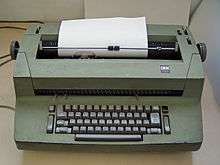IBM Selectric typewriter

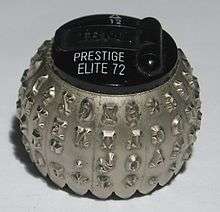
The IBM Selectric typewriter was a highly successful model line of electric typewriters introduced by IBM on 31 July 1961.[1][2]
Instead of the "basket" of individual typebars that swung up to strike the ribbon and page in a traditional typewriter, the Selectric had a type element (frequently called a "typeball", or more informally, a "golf ball") that rotated and pivoted to the correct position before striking. The type element could be easily changed so as to print different fonts in the same document, resurrecting a capability that had been pioneered by the Blickensderfer typewriter almost 70 years before. The Selectric also replaced the traditional typewriter's moving carriage with a paper roller ("platen") that stayed in position while the typeball and ribbon mechanism moved from side to side.
The Selectric mechanism was notable for using internal mechanical binary coding and two mechanical digital-to-analog converters, called whiffletree linkages, to select the character to be typed.
Selectrics and their descendants eventually captured 75 percent of the United States market for electric typewriters used in business.[3] IBM replaced the Selectric line with the IBM Wheelwriter in 1984 and transferred its typewriter business to the newly formed Lexmark in 1991.[4]
History, models, and related machines

Original Selectric
The Selectric typewriter was introduced on 23 July 1961. Its industrial design is credited to influential American designer Eliot Noyes. Noyes had worked on a number of design projects for IBM; prior to his work on the Selectric, he had been commissioned in 1956 by Thomas J. Watson, Jr. to create IBM's first house style: these influential efforts, in which Noyes collaborated with Paul Rand, Marcel Breuer, and Charles Eames, have been referred to as the first "house style" program in American business.[3]
Selectric II
The Selectric remained unchanged until 1971 when the Selectric II was introduced.[5] The original design was thereafter referred to as the Selectric I. These machines used the same 88-character typing elements. However they differed from each other in many respects:
- The Selectric II was available with a Dual Pitch option to allow it to be switched (with a lever at the top left of the "carriage") between 10 and 12 characters per inch, whereas the Selectric I was ordered with one "pitch" or the other. Separate typeballs were available for each pitch.
- The Selectric II had a lever (at the top left of the "carriage") that allowed characters to be shifted up to a half space to the left (for centering text, or for inserting a word one character longer or shorter in place of a deleted mistake), whereas the Selectric I did not. This option was available only on dual pitch models.
- Stylistically, the Selectric II was squarer at the corners, whereas the Selectric I was rounder.
Correcting Selectric II
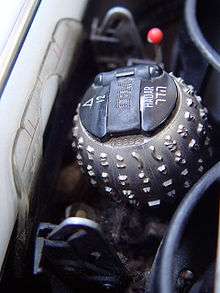
In 1973 the Correcting Selectric II was announced. It added an internal correction feature to the Selectric II, intended to eliminate the need for typists to use cover-up tape, "white-out" correction fluid, or typewriter erasers. The carriage on this machine held both the main typing ribbon cartridge and two small spools for a correction ribbon. A new ribbon type, the Correctable Film ribbon, was introduced at the same time. This produced typing quality equal to the carbon film ribbon, but with a pigment designed to be easily removable from paper.
There were two types of correction tapes: The transparent and slightly adhesive "Lift-Off" tape (for use with the correctable film ribbon), or the white "Cover-Up" tape (for cloth, Tech-3, and carbon film ribbons). The correction tape was changed independently from the typing ribbon.
The correction key (an extra key at the bottom right of the keyboard) backspaced the carriage by one space and also put the machine in a mode wherein the next character typed would use the correction tape instead of the normal ribbon, and furthermore would not advance the carriage. The typist would press (and release) the correction key and then re-type the erroneous character, either lifting it off of the page or (if using other than the correctable ribbon) covering it with white-out powder, then type the correct character. Any number of mistakes could be corrected this way, but the process was entirely manual, as the machine had no memory of the typed characters.
Selectric-based machines with data storage
In 1964 IBM introduced the "Magnetic Tape Selectric Typewriter" and in 1969, a "Magnetic Card Selectric Typewriter." These were sometimes referred to as the "MT/ST" and "MC/ST", respectively. The MC/ST was also available in a "communicating" version that could emulate an IBM 2741 terminal or run its native Correspondence Code. These featured electronically interfaced typing mechanisms and keyboards and a magnetic storage device (either tape in a cartridge, or a magnetic-coated card the same size as an 80-column punched card) for recording, editing, and replaying typed material at ca. 12–15 characters per second.
These machines were among the first to provide word processing capability in any form. They used the same elements as ordinary office Selectrics.
In 1972, the "Mag Card Executive" was offered. Like IBM's earlier typebar-based "Executive" models this offered proportional spacing, based on multiples of a 1/60" unit size. Unlike the various "Selectric Composer" models, there was no provision for setting the machine to vary the letter and word spacing to create justified copy. Some of the typestyles originally offered with the Mag Card Executive would later be made available for the Model 50 electronic typewriter, which supported proportional spacing with 96-character elements.
In April 1973 the IBM Mag Card II Typewriter was announced, providing space for up to 8,000 characters in electronic memory.
IBM also sold a tape reader that could be connected to 360 series mainframes, and would read the MT/ST tapes. Thus a document typed on an MT/ST Selectric could also be entered into a mainframe data file.
Selectric Composer
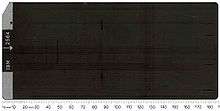
In 1966, IBM released the Selectric Composer.[6] This highly modified (and much more expensive) Selectric produced camera-ready justified copy using proportional fonts in a variety of font styles from 8 points to 14 points.[7] Material prepared on a properly adjusted machine by a skillful operator and printed onto baryta (barium sulfate-coated) paper "would take an expert to tell... [that it] was not the product of a Linotype or Monotype machine".[8]
Characters were proportionally spaced, being from 3 to 9 units wide, with the size of a unit being selectable as either 1/72", 1/84", or 1/96", to allow for different sizes of type (10, 12, or 15 characters per inch). Tab stops could only be positioned at intervals of one-sixth of an inch, or one pica. To support backspacing over previously typed characters, the spacing code for the last 40 or so characters typed was mechanically stored by small sliding plates in a carrier wheel.
Like the Varityper with which it competed, the original machine required that material be typed twice if the type was to be justified. The first time was to measure the length of the line and count the spaces, recording measurements read from a special dial on the right margin. The second time it was typed, the operator set the measurements into the dial to set justification for each line. The process was tedious and slow, but provided a way to get camera-ready, proportionally spaced, justified copy from a desk-sized machine.

The typeball elements for the Selectric Composer would physically fit on a Selectric, and vice versa, but they could not actually be used on each other's machines, because the characters were arranged differently around the element and were also positioned differently within each character area. Selectric Composer elements can be identified by a colored index arrow (the color is used to set a median character width on the machine) and an abbreviated series of letters and numbers identifying the font, size, and variation, for example "UN-11-B" for Univers 11-point bold (Adrian Frutiger had adapted his Univers font specifically for the Selectric Composer).[9]
In addition to Univers, a Century, Times Roman, and later an "Aldine" font (Bembo) were available, as was a Symbols font. However, the Composer, with its relatively small market, never had anything like the variety of typeballs available as there were for the Selectric (see below). Each font required separate typeballs for italic and bold versions, and a separate set of roman/italic/bold balls was required for each size of type. (Not all fonts were available in bold and italic in every size.) The need to change typeballs frequently, sometimes multiple times in the same sentence, slowed work down and was a source of owner dissatisfaction. (In typical use, Selectric typeballs were changed infrequently.) The balls themselves were somewhat fragile and not designed to resist frequent handling.
The following fonts were available for the Composer:
- Aldine Roman (a version of Bembo)
- Baskerville
- Bodoni
- Century (actually Century Expanded)
- Classified News (a version of News Gothic)
- Copperplate Gothic
- Journal Roman (a version of Janson)
- Press Roman (a version of Times Roman). Includes Press Roman Symbol (Greek, Mathematical, Technical).
- Pyramid (a version of Memphis)
- Theme (a version of Optima)
- Univers
- Ruling Font[10]
In contrast with the Selectric, only IBM made typeballs for the Composer.
In 1967, a "Magnetic Tape Selectric Composer" appeared, and in 1978, a "Magnetic Card Selectric Composer." The "Electronic Composer" (with approximately 5000 characters of internal memory, similar to the later Magnetic Card model but without external storage) was marketed from 1975. All these models used the same Selectric Composer as output (printing) mechanism. However, due to the magnetic or internal storage, they avoided the need to type justified text twice or to manually set the mechanism for the justification needs of each line. Furthermore, tapes or cards originally recorded on the much less expensive and easier to operate Selectric typewriter versions, the MT/ST or MC/ST, could be read by the "Composer" equivalents.
For a number of years after its introduction, the Selectric Composer was considered to be a highly desirable, powerful desk-sized cold type setting system, affordable by small businesses and organizations. It was usually leased, including a service contract for the skilled labor required to fix and adjust it. The Selectric Composer was accorded respect and affection among small publishers, unrivaled until the appearance of the Apple Macintosh, laser printer, and desktop publishing software.[11][12] Ultimately the system proved a transitional product, as it was displaced by cheaper phototypesetting, and then in the 1980s by word processors and general-purpose computers.[13]
Selectric III
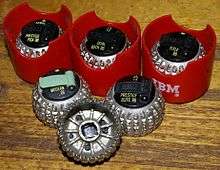
In the 1980s IBM introduced a Selectric III and several other Selectric models, some of them word processors or typesetters instead of typewriters, but by then the rest of the industry had caught up with the trend, and IBM's new models did not dominate the market the way the first Selectric had. This was to be expected, as by the late 1970s the Selectric typewriter's dominance was under assault from both 35-45 character per second proportional-spacing electronic typewriters with inbuilt memory (e.g. the 800 from Xerox based on Diablo's "daisywheels" and from OEMs of Qume who had a similar printwheel technology) and CRT-based systems from AES, Lexitron, Vydek, Wang and Xerox (see the Word Processor article for further details of these brands). In addition, IBM had already (c. 1977) brought to market the CRT-based Office System/6 (from Office Products Division)[14] and 5520 [15] (from IBM General Systems Division (GSD)) both of which used the new 6640 inkjet printer capable of 96 characters per second with two paper trays and sophisticated envelope handling, and was about to introduce Qume-based printers for the existing System/6 range and the new Displaywriter[16] launched in June 1980 and described by IBM as "not your father's Selectric."
Nevertheless, IBM had a large installed base of Selectric typewriters and to retain customer loyalty it made sense to introduce updated models.
The Selectric III featured a 96-character element vs. the previous 88-character element. IBM's series of "Electronic Typewriters" used this same 96-character element. The 96-character elements can be identified by yellow printing on the top plastic surface and the legend "96," which always appears along with the font name and pitch. The 96- and 88-character elements are mechanically incompatible with each other (they won't fit on each other's machines) and 96-character elements were not available in as many fonts as the older 88-character types.
Most Selectric IIIs and Electronic Typewriters only had keys for 92 printable characters; the 96-character keyboard was an optional feature. Fitting the additional keys onto the keyboard required shrinking of the Return key and this was annoying to many typists, so it was not the default configuration. The keytops on the Selectric III and Electronic Typewriters were larger and more square than those on earlier Selectrics.
Replacement
.jpg)
IBM introduced the IBM Wheelwriter in 1984 as a replacement for the Selectric. The Wheelwriter featured a replaceable daisy wheel cartridge, had electronic memory, and offered many word processing features.
Layout
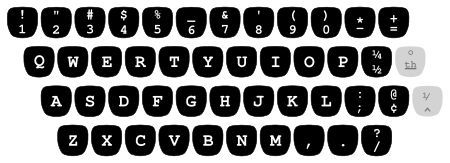

The Selectric keyboard layout differed in certain ways from the traditional layout of mechanical typewriters, notably in the placement of symbols, which largely dated back to the Remington No. 2 (1878), the first typewriter with a shift key and extensive symbols. Notably, it moved "_' off of the digits 268, replacing them with @^*, and instead placing '" and -_ as pairs on keys. This change was made because smaller characters hit the paper with less force, and consolidating smaller characters such as '" into a pair on a single key avoided needing to adjust the force based on shift state.[17] The Selectric layout became standard for electric typewriters in the US, and was inherited by the IBM PC (1981), and thence by many computer keyboards, particularly via the influential Model M (1985). In computer keyboard standards, this was formalized in the American Standards Association X4.14-1971 standard as typewriter pairing (colloquially a typewriter-paired keyboard), along with bit-paired keyboards, but became the only standard in the successor X4.23-1982 standard.
The Selectric keyboard layout was so influential that two decades later PC Magazine wrote that non-IBM personal computer companies' keyboards "slavishly" imitated it.[18] The new layout was not universal, however – internationally, many layouts kept the earlier standard, which is most visible in ⇧ Shift+2 yielding ", as on the standard UK layout. Also, the bit-paired keyboard layout mostly died out, but is retained in the Japanese keyboard layout.
Selectric mechanism
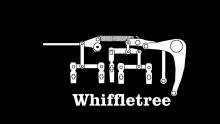
Mechanically, the Selectric borrowed some design elements from a toy typewriter produced earlier by Marx Toys. IBM bought the rights to the design.[19] The typeball and carriage mechanism was similar to the design of the Teletype Model 26 and later, which used a rotating cylinder that moved along a fixed platen.[20]
The mechanism that positions the typing element ("ball") takes a binary input, and converts this to character offsets using two mechanical digital-to-analog converters, which are "whiffletree" linkages of the type used for adding and subtracting in linkage-type mechanical analog computers. (The nomenclature used by IBM Office Product Customer Engineers and in IBM maintenance publications for the machine's "whiffletrees" is "Rotate and Tilt Differentials.") Every character position on the element has a two-part binary code, one for tilt and one for rotate.
The motor at the back of the machine drives a belt connected to a two-part shaft located roughly halfway through the machine. The cycle shaft on the left side powers the tilt and rotate mechanism. The operational shaft on the right side powers functions such as spacing, backspacing, and case shifting, as well as serving as a governor, limiting the left-to-right speed with which the carrier moves. A series of spring clutches power the cams which provide the motion needed to perform functions such as backspacing.
When the typist presses a key, a pawl on the key lever depresses a matching metal bar (interposer) for that key. The interposer, which is oriented front to back in the machine, has one or more short projections (lugs) protruding from its bottom edge. Each interposer has a unique combination of lugs, corresponding to the binary code for the desired character. Each interposer also has a tab that slots in between loose steel balls in a race, the size of balls and race selected precisely to leave a total gap barely larger than the width of the interposer tab, such that only one interposer tab can fit in the free space and thus only one letter can be selected at a time.[21]
When the interposer is depressed, it engages a metal bar (cycle clutch latch link) that connects the clutch on the cycle shaft for one cycle, providing power to the filter shaft, whose lobes thrust the interposer towards the front (operator end) of the machine. When the interposer moves, each of its lugs engages one of a set of bars (selector bails) that run from left to right across the keyboard mechanism. In a machine with a North American keyboard, there are five "negative logic" selector bails (two for tilt and three for rotation), and one "positive logic" bail (called "minus five") for accessing characters in the opposite direction of rotation.[21]
Each negative logic selector bail that is displaced by the interposer in turn pulls a latch interposer and link which causes a selector latch near the cycle shaft to be pulled away from the latch bail. The latches pulled away in this manner are disengaged for the rest of the cycle, while the remaining latches take part in character selection, hence the term "negative logic". The minus five selector bail pulls an interposer and link which causes a latch to disengage from a cam, allowing it to move an additional input into the whiffletree that subtracts five units of rotation from any negative logic inputs. An additional "low velocity" selector latch is also engaged by certain keys, such as '.' and '_', which require a reduced striking force so as not to cut the paper; this selector latch engages the low velocity control cam follower, which pulls the low velocity cable connected to the cam in the carrier, causing the low velocity lobe to be used instead of the usual high velocity lobe.[21] Additionally, punctuation marks are deliberately placed about the ball so the maximum amount of energy is used to position the element prior to striking, further reducing the impact.
The selector latches that remain engaged with the latch bail cause cams on the drive shaft (which is rotating) to move the ends of the links in the whiffletree linkage, which sums (adds together) the amounts ("weights") of movement corresponding to the selected bits. The sum of the weighted inputs is the required movement of the typing element. There are two sets of similar mechanisms, one for tilt, one for rotate. The type element has four rows of 22 characters. By tilting and rotating the element to the location of a character, the element can be thrust against the ribbon and platen, leaving an imprint of the chosen character.
Tilt and rotate movements are transferred to the ball carrier (the mechanism that supports the type element), which moves across the page, by two taut metal tapes, one for tilt and one for rotate. The tilt and rotate tapes are both anchored to the right side of the carrier. They both wrap around separate pulleys at the right side of the frame; the tilt pulley is fixed, while the rotate pulley is attached to the shift arm, actuated by the Shift and Caps Lock keys.[22] The tapes extend across the machine behind the carrier, and then wrap around two separate pulleys at the left side of the frame. The tilt tape is then anchored to a small, quarter-circle pulley which, through a link, tips the tilt ring (the device to which the type element is connected) to one of four possible locations. The rotate tape is wrapped around a spring-loaded pulley located in the middle of the carrier. The rotate pulley under the tilt ring is connected through a universal joint (called a "dog bone", which it resembles) to the center of the tilt ring. The type element is spring-latched onto that central post. The type element rotates counter-clockwise when the rotate tape is tightened. The spiral "clock" spring underneath the rotate pulley rotates the element in the clockwise direction. As the carrier moves across the page (such as when it returns), the tapes travel over their pulleys, but the spring-loaded pulleys on the ball carrier do not pivot or rotate.
To position the ball, both of the pulleys on the left side of the frame are moved by their whiffletree linkages, actuated by the selected drive shaft cams. When the rotate pulley is moved to the right or left, the rotate tape spins the type element to the appropriate location. When the tilt pulley is moved, it tips the tilt ring to the appropriate location. When it moves, the tape rotates the spring-loaded pulley on the ball carrier independent of the carrier's location on the page.
Case is shifted from lowercase to uppercase (and associated shifted punctuation symbols) by rotating the element by exactly half a turn. This is accomplished by moving the right-hand rotate pulley via the shift arm, using a cam mounted on the end of the operation shaft; the additional cable tension adds 180° to any rotation from the whiffletree.
After a character is struck on the paper, the mechanism is reset, including replacing all latches on their bails and moving the interposer back into position. If the key that was pressed is still down at this time, the interposer rotates the keylever pawl out of the way to prevent key repeat until the key is released and depressed again, starting the next cycle.[21]
The complex Selectric system was highly dependent upon lubrication and adjustment, and much of IBM's revenue stream came from the sale of Service Contracts on the machines. Repair was fairly expensive, so maintenance contracts were an easy sell.
Both Selectric and the later Selectric II were available in standard, medium, and wide-carriage models and in various colors, including red and blue as well as traditional neutral colors.
Ribbons
In addition to the "typeball" technology, Selectrics were associated with several innovations in ink ribbon design.
The original Selectric had to be ordered to use either cloth reusable ribbon or one-time carbon film ribbon; the same machine could not use both. This was also true of the original, non-correcting Selectric II. IBM had used a similar carbon film ribbon on their earlier Executive series of typewriters. As with these older machines, the carbon film ribbon presented a security issue in some environments: It was possible to read the text that had been typed from the ribbon, seen as light characters against the darker ribbon background.
The Correcting Selectric II used a new ribbon cartridge mechanism. The cartridge contained both supply and take-up spools, permitting both easy ribbon changes and the use of several types of ribbon on one machine. The ribbons were wider than had been used previously, giving more typed characters per inch of ribbon. Successive characters were staggered vertically on the ribbon, which incremented less than a full character position each time. Different types of ribbons had different-depth holes in the bottom of the cartridge, which set the mechanism to advance the ribbon by the amount appropriate for the type of ribbon.
Three types of ribbons were initially available for the Correcting Selectric II: Reusable cloth ribbon (essentially the same as had been used on typewriters for decades); carbon film ribbon, like that used on earlier Selectrics; and the new Correctable (carbon) Film ribbon. The latter used a carbon pigment similar to that on the regular carbon film ribbon, but its binder did not permanently adhere to the paper. This permitted the use of the adhesive Lift-Off correction tape in the new machine, producing a very "clean" correction. The other types of ribbons required Cover-Up tape, which deposited a white ink on top of the characters being corrected. This complicated corrections on paper colors other than white.
Shortly after the machine was introduced, a "Tech-3" ribbon appeared. It essentially replaced the cloth ribbon, as it offered typing quality close to the film ribbon but at a use cost comparable to the reusable cloth. Like the cloth ribbon, Tech-3 ribbons incremented only a fraction of the character width after being struck. Unlike the cloth ribbon, the Tech-3 ribbon provided high quality impressions for several characters from each spot on the one-time-use ribbon. Because characters overstrike each other on a Tech-3 ribbon several times it could not be easily read to discover what had been typed. The Tech-3 ribbon offered equivalent security to the carbon film ribbon, as its impressions were permanent as soon as they were struck. The Tech-3 ribbon was used with the same cover-up tape that worked with the other non-correctable ribbons.
The thumb wheel on the ribbon cartridge and the correction tape spools were color-coded so they could be easily identified and matched with the appropriate correction tapes: Yellow for the correctable film ribbon and Lift-Off tape; gray, pink, and blue for cloth, carbon film, and Tech-3, respectively. Later another type of correctable film ribbon and lift-off tape appeared, both color-coded orange. The yellow meant the ribbon was a higher quality and would produce a better quality type image. Orange was a lower cost ribbon for everyday typing. The yellow and orange coded lift-off tapes would work with either ribbon type.
The slightly adhesive Lift-Off tape would sometimes damage more delicate paper surfaces. A less "sticky" version of these tapes was eventually offered, but some people believed it did not remove the ink as well. Some typists found that a piece of adhesive tape such as "Scotch" tape could be used in place of lift-off tape.
Some colored ribbons (such as brown) were also available. The ribbon cartridge mechanism did not allow the use of two-color ribbons, such as black and red, that had been common on earlier typewriters.
Type elements and fonts

The Selectric I, Selectric II, and all of the "Magnetic Card" and "Magnetic Tape" variations except for the Composers, use the same typing elements. These are available in many fonts, including: symbols for science and mathematics, OCR faces for scanning by computers, cursive script, "Old English" (fraktur), and more than a dozen ordinary alphabets. The Israeli typographer Henri Friedlaender designed the Hebrew fonts Hadar, Shalom & Aviv for the Selectric. The Selectric III and "Electronic Typewriters" used a new 96-character element.
IBM also produced computer terminals based on the Selectric mechanism, some of which (all models of the IBM 1050 series, and IBM 2741 models using "PTTC/BCD" code) used a different encoding. Though the elements were physically interchangeable, the characters were differently arranged, so that standard Selectric elements could not be used in them, and their elements could not be used in standard Selectrics. On the other hand, IBM 2741s using "correspondence coding" used standard office Selectric elements. The IBM 1130 computer used a Selectric mechanism as the console printer.
There were two visibly different styles of mechanical design for the elements. The original models had a metal spring clip with two wire wings that were squeezed together to release the element from the typewriter. Later models had a plastic lever molded around a metal axle which pried apart the now-internal spring clip. This had a tendency to break where the lever joined the axle. The Selectric element was later redesigned to have an all-plastic lever.
The font size was measured not in points but in pitches that is the number of letters per one inch of the typed line. As a result, 12-pitch fonts (12 letters per inch) were actually smaller than 10-pitch fonts (10 letters per inch), and roughly corresponded to the 10pt and 12pt traditional typographic font sizes.[23]
Some of the interchangeable font elements available for the Selectric models included:
Small (12-pitch) fonts
|
Large (10-pitch) fonts
|
Starred fonts were 96-character elements made for the Selectric III.
Many of the fonts listed here came in several sub-varieties. For example, in the early years of the Selectric, typists were used to using the lower-case L for the numeral 1, as many previous typewriters lacked a dedicated numeral 1 key. The Selectric had a dedicated key for 1/!, but this was also marked [/], as many of the early elements had square brackets in these positions. Using such an element required the typist to continue the old convention. Later elements tended to have the dedicated numeral 1 and exclamation point characters instead. Some moved the square brackets to the positions formerly occupied by the 1/4 and 1/2 fractions, while others lost them completely. Some put a degree symbol in place of the exclamation point. IBM would furthermore customize any element for a fee, so literally endless variations were possible. Such customized elements were identified by a gray plastic flip-up clip instead of a black one.
Many specialized elements were not listed in IBM's regular brochure, but were available from IBM provided the right part number was known. For example, the element for the APL programming language was available. This element was really intended for use with the IBM 2741 printing terminal. The IBM 1130 also used this element when running APL\1130.
Features and uses
The ability to change fonts, combined with the neat regular appearance of the typed page, was revolutionary, and marked the beginning of desktop publishing. Later models with dual pitch (10/12) and built-in correcting tape carried the trend even further. Any typist could produce a polished manuscript.
The possibility to intersperse text in Latin letters with Greek letters and mathematical symbols made the machine especially useful for scientists writing manuscripts that included mathematical formulas. Proper mathematical typesetting was very laborious before the advent of TeX and done only for much-sold textbooks and very prestigious scientific journals. Special type balls also were released for the Athabaskan languages, allowing Navajo and Apache bilingual programs in education to be typed for the first time.[24]
The machine had a feature called "Stroke Storage" that prevented two keys from being depressed simultaneously. When a key was depressed, an interposer, beneath the keylever, was pushed down into a slotted tube full of small metal balls (called the "compensator tube") and spring latched. These balls were adjusted to have enough horizontal space for only one interposer to enter at a time. (Mechanisms much like this were used in keyboards for teleprinters before World War II.) If a typist pressed two keys simultaneously both interposers were blocked from entering the tube. Pressing two keys several milliseconds apart allows the first interposer to enter the tube, tripping a clutch which rotated a fluted shaft driving the interposer horizontally and out of the tube. The powered horizontal motion of the interposer selected the appropriate rotate and tilt of the printhead for character selection, but also made way for the second interposer to enter the tube some milliseconds later, well before the first character had been printed. While a full print cycle was 65 milliseconds this filtering and storage feature allowed the typist to depress keys in a more random fashion and still print the characters in the sequence entered.
The space bar, dash/underscore, index, backspace and line feed repeated when continually held down. This feature was referred to as "Typamatic."
Use as a computer terminal

Due to their speed (14.8 characters per second), immunity to clashing typebars, trouble-free paper path, high quality printed output, and reliability, Selectric-based mechanisms were also widely used as terminals for computers, replacing both Teletypes and older typebar-based output devices. One popular example was the IBM 2741 terminal. Among other applications, the 2741 (with a special typing element) figured prominently in the early years of the APL programming language.
Despite appearances, these machines were not simply Selectric typewriters with an RS-232 connector added. As with other electric typewriters and electric adding machines of the era, Selectrics are electromechanical, not electronic, devices: The only electrical components are the power cord, power switch, and electric motor. The electric motor runs continuously. The keys are not electrical pushbuttons such as those found on a computer keyboard. Pressing a key does not produce an electrical signal as output, but rather engages a series of clutches which couple the motor power to the mechanism to turn and tilt the element. A Selectric would work equally well if hand-cranked (or foot-powered, like treadle powered sewing machines) at sufficient speed.
The original Selectric mechanism was designed and manufactured by the office equipment division of IBM and was not engineered for use as a computer terminal. Adapting this mechanism to the needs of computer input/output was not simple. Microswitches were added to the keyboard, solenoids were added to allow the computer to trigger the typing mechanism, and interface electronics were also needed. Several mechanical components, in particular the motor and the main clutch, had to be upgraded from the typewriter versions to reliably support continuous operation. Additional microswitches had to be added to sense the state of various parts of the mechanism, such as case (upper vs. lower).
Even after adding all those solenoids and switches, getting a Selectric to talk to a computer was a complicated project. The Selectric mechanism had many peculiar requirements.[25] If commanded to shift to upper case when it was already in upper-case, the mechanism locked up and never signaled "done." The same applied to shifting the ribbon direction or initiating a carriage-return. These commands could only be issued at particular times, with the Selectric in a particular state, and then not again until the terminal signaled the operation was complete.
In addition the Selectric mechanism natively used a unique code based on the "tilt/rotate" commands to the golf ball. That and the bit-parallel interface and peculiar timing requirements meant the Selectric could not be directly hooked up to a modem. Indeed, it needed a relatively large amount of logic to reconcile the two devices, and the interface logic often outweighed the printing mechanism in the early years.
The optimum data rate used to drive the Selectric mechanism turned out to be equivalent to 134.5 baud, which was a highly unusual data rate before the appearance of the mechanism. Driving the Selectric mechanism at the more-standard rate of 110 baud appeared to work well, although at a slightly slower speed. However, driving the mechanism at a non-optimal rate would soon result in its failure, by forcing an internal start-stop clutch to actuate for each character typed, thus wearing it out very rapidly. Continuous typing at the proper 134.5 baud rate would engage the clutch only at the beginning and end of a long sequence of characters, as designed.
The popularity of the Selectric mechanism caused computer manufacturers such as Digital Equipment to support the 134.5 baud data rate on their serial computer interfaces, enabling connection of IBM Type 2741 terminals.[26][27] The 2741 was available with two different seven-bit codes (Correspondence and PTT/BCD). Code choice affected the font elements which could be used. The host computer had to translate the 2741 code into the host’s internal code (usually ASCII or EBCDIC). Dedicated hardware was also built to drive Selectric printers at 134.5 baud.[28]
Particularly vexing was the Selectric's lack of a full ASCII character set. The late Bob Bemer wrote[19] that while working for IBM he lobbied unsuccessfully to expand the typing element to 64 characters from 44. The Selectric actually provided 44 characters per case, but the point remains that with 88 printable characters it could not quite produce the full printable ASCII character set.
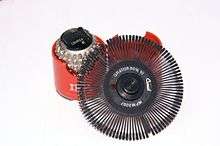
Since the keyboard was mechanically connected directly with the printer mechanism, keyboard character inputs were immediately typed by the printer mechanism, behavior called half-duplex by most of the computer industry. However, IBM insisted on calling this behavior full duplex, causing much confusion. If the computer system in turn echoed the typed input, having been configured to expect a full-duplex terminal, the echoed output would look something like tthhiiss. A further discussion of this terminology can be seen in the article on terminal emulation and elsewhere.[29]
Another odd feature of the Selectric terminals was the "keyboard lock" mechanism. If the computer system a user was communicating with was too busy to accept input, it could send a code to mechanically interlock the keyboard so the user could not press any keys. The keyboard was also locked when the computer was typing, to avoid damaging the mechanism or interleaving user input and computer output in a confusing manner. Though done to protect the print mechanism from damage,[27] an unexpected keyboard lock activation could cause minor injury to a typist with a heavy touch. There was little obvious warning that the keyboard had locked or unlocked, other than a faint click from the interlock solenoid, easily drowned out by the printer and fan noise in many computer facilities. There was a small indicator light, but this was of little help to fast touch typists whose gaze was fixed on copy they were transcribing.
The 2741 Selectric also had a special "print inhibit" feature.[30] When the terminal received such a command from a host computer, the typeball element still operated, but did not print on the paper. This feature was used to avoid printing computer login passwords, and for other special purposes.
In spite of all these idiosyncrasies, between 1968 and about 1980, a Selectric-based printer was a relatively inexpensive and fairly popular way to get high-quality output from a computer. A minor industry developed to support small businesses and leading-edge hobbyists who would obtain a Selectric mechanism (which cost much less than a full-fledged 2741 terminal) and modify it to interface with industry-standard serial data communications.[31]
The 96-character typeball element introduced with the Selectric III and Electronic Typewriter series could (with some customizations) handle the full ASCII character set, but by that time the computer industry had moved on to the much faster and mechanically simpler daisy wheel mechanisms such as the Diablo 630. The typewriter industry followed this trend shortly afterward, and even IBM replaced their Selectric lineup with the daisy wheel-based "Wheelwriter" series.
Similar machines referred to as the IBM 1050 series were used as the console printers for many computers, such as the IBM 1130 and the IBM System/360 series. The IBM 1050 was also offered in a remote terminal configuration, similar in use to the 2741.[27] These were designed and manufactured for this purpose, including the necessary electrical interfaces, and incorporated more rugged components than the office Selectric or even the 2741.
In popular culture
- Capitalizing on the then-new Selectric typewriters, the IBM Pavilion at the 1964 New York World's Fair was a large theater shaped and styled to look somewhat like a giant Selectric type element.
- Notable Selectric users include Isaac Asimov,[32] Hunter S. Thompson, David Sedaris, P. J. O'Rourke,[33] and Stephen J. Cannell.
- Aaron Sorkin credits a Selectric typewriter with interesting him in becoming a writer (although he now writes his stories on Apple Macintosh laptops).
- The 1963 Perry Mason story "The Case of the Elusive Element" turned on the fact that the pivoting typeball ("element") in Selectric typewriters could easily be switched, making it impossible to know which machine had actually been used to type a message.
- In the final scenes the film Z (1969) directed by Costa-Gavras, the camera zooms on a Selectric typeball hammering the deposition while the State Prosecutor interrogates and indicts the military officers for murder.
- The title sequence of Gerry Anderson's 1970 TV series UFO featured close-ups of a Selectric-based machine.
- In the TV series Mad Men, which is set during the early- to mid-1960s, Selectric II typewriters are featured prominently on the secretaries' desks, even though they were not introduced until 1971. In his 2008 DVD commentary, creator Matthew Weiner said the Selectric was chosen for his show for aesthetic reasons and because of the difficulty of assembling the required number of period-appropriate conventional electric typewriters.
- In Stanley Kubrick's 1971 film adaptation of A Clockwork Orange, the writer attacked by Alex is shown using a Selectric typewriter.
- In the 2002 film Secretary, a Selectric II is shown being used by Maggie Gyllenhaal, playing the newly hired secretary Lee Holloway.
- In Philip Roth's novel The Anatomy Lesson, character Nathan Zuckerman dismisses the self-correcting Selectric II as "smug, puritanical, workmanlike" compared to his old Olivetti portable.
- In the 1976 Columbo story "Now You See Him", Jack Cassidy's perfect murder is foiled when the detective reads the killer's motive on the victim's used Selectric II carbon film ribbon.
- Philip K. Dick wrote his novels on an IBM Selectric, from 1976 (or earlier) until his death.
- The character Karen Eiffel, played by Emma Thompson in the 2006 dramatic comedy film Stranger than Fiction, writes her novel Death and Taxes on a Selectric II typewriter.
- In seasons 2 and 3 of Fringe, a Selectric II typewriter is used as a communication device to send messages to the other dimension.
- In Stephen King's novel Bag of Bones, main character Michael Noonan types his early novels using a Selectric, and his rediscovery of the machine several years later helps him to both (temporarily) conquer a cataclysmic case of writer's block and serve as a clue regarding his late wife's activities in the last year of her life.
- In the TV series Californication, lead character Hank Moody is a writer who uses a Selectric II.
- In the 1980 workplace comedy film 9 to 5, Selectric-based typewriters (made by Royal) are shown on many of the secretaries' desks: at one point, a shot appears of Dolly Parton typing a memo, which then zooms to highlight what she's typing, showing a closeup of the printball.
- In Régis Roinsard's 2012 film Populaire about a boss training his secretary to become the 1959 world speed typing champion, he also invents the "golf ball" typewriter mechanism, which his American friend pitches to American typewriter manufacturers with the words "America for business, France for love".
References
- ↑ "History of the IBM Typewriter".
- ↑ Carriageless Typewriter Shown; New I.B.M. Selectric Can Accommodate Six Print Fonts, New York Times, 1 August 1961, "An electric typewriter that eliminates type bars and movable carriages and that can use six interchangeable type faces was introduced by the International Business Machines Corporation yesterday..."
- 1 2 "Eliot Fette Noyes, FIDSA". Industrial Design Society of America--About ID. Retrieved 2009-11-18.
- ↑ IBM Typewriter milestones
- ↑ History of the IBM Typewriter
- ↑ A preface and 13 articles on the philosophy and construction of the Composer were published in the IBM Journal of Research and Development, issue 1, January 1968, available at http://ieeexplore.ieee.org/xpl/tocresult.jsp?isnumber=5391916, consulted August 3, 2015.
- ↑ Miles, B.W.; Wilson, C.C. (11 April 1967). "The IBM Selectric Composer: Proportional Escapement Mechanism" (PDF). IBM Journal of Research and Development. IBM. doi:10.1147/rd.121.0048. Retrieved 2007-12-12.
- ↑ John Lewis (1978). Typography: Design and Practice. p. 118. Retrieved 2009-03-03.
- ↑ Frutiger, Adrian (27 February 1967). "The IBM Selectric Composer: The Evolution of Composition Technology". IBM Journal of Research and Development. IBM. 12 (1): 9–14. doi:10.1147/rd.121.0009. Retrieved 2007-12-12.
- ↑ Luc Devroye, http://luc.devroye.org/fonts-59656.html, consulted August 3, 2015.
- ↑ Nielsen Hayden, Teresa. "Back when IBM had balls". Making Light: Incorporating Electrolite. Retrieved 2011-04-06.
- ↑ Stamm, Swiss Foundation Type and Typography ; edited by Heidrun Osterer and Philipp (2009). Adrian Frutiger typefaces : the complete works (English ed.). Basel: Birkhäuser. p. 192. ISBN 978-3764385811.
- ↑ McEldowney, Dennis (1 October 2013). A Press Achieved: the Emergence of Auckland University Press, 1927-1972. Auckland University Press. pp. 102–5. ISBN 978-1-86940-671-4.
- ↑ "IBM enters 'the office of the future'". Krsaborio.net. 14 February 1977. Retrieved 2011-11-18.
- ↑ IBM Archives: IBM 5520 Administrative System
- ↑ "IBM Archives: IBM Displaywriter". 03.ibm.com. Retrieved 2011-11-18.
- ↑ John J. G. Savard. "Computer Keyboards". Retrieved 2014-08-24.
- ↑ Edlin, Jim (November 1982). "The PC's Keys". PC Magazine. p. 175. Retrieved 21 October 2013.
- 1 2 Bemer, Bob. "IBM — The Selectric Typewriter (and Computer Standards)". Retrieved 2016-02-15.
- ↑ Nelson, R.A. "History Of Teletype Development". Retrieved 2008-01-25.
- 1 2 3 4 IBM Selectric Typewriter Learning Program 10-3A: Input
- ↑ IBM Selectric Typewriter Learning Program 10-4A: Printing Mechanism
- ↑ Coles-Mogford, Anne; Drummond, Archie (1994). Applied typing and information processing (6th ed.). Nelson Thornes. p. 198. ISBN 9780748718979.
- ↑ Christal, Mark. "Virtual Museum Projects for Culturally Responsive Teaching in American Indian Education." Dissertation. 2003:
- ↑ IBM Customer Engineering. "Selectric I/O Keyboard Printer" (PDF). IBM Office Products Division. Retrieved 2011-04-09.
- ↑ Van Vleck, Tom. "Multics : Glossary : A : 2741". Retrieved 2011-04-09.
- 1 2 3 Van Vleck, Tom. "Multics : Home Terminals". Retrieved 2011-04-09.
- ↑ Mills, David. "Technical Report 8: The Data Concentrator". University of Michigan. Retrieved 2011-04-09.
- ↑ Cisco Systems Inc. "Internetwork Design Guide -- IBM Serial Link Implementation Notes". Cisco Systems Inc. Retrieved 2011-04-09.
- ↑ IBM Systems Development Division. "IBM 2741 Communication Terminal" (PDF). IBM Systems Reference Library. IBM Systems Development Division. Retrieved 2015-10-06.
- ↑ vintage-computer.com. "Interfacing IBM Selectric to IO Port?". vintage-computer.com. Retrieved 2011-04-09.
- ↑ Asimov, Isaac (1980). In Joy Still Felt. Doubleday. pp. 597–598.
- ↑ "I do all my writing on an ancient IBM Selectric. [] If I had a computer I would do nothing but play with it all day."
External links
- History of typewriter design, featuring the Selectric.
- Selectric Typewriter Museum
- The IBM Selectric Composer desktop typesetting system
- IBM Archives: Office Product Division Highlights
- Video by Bill Hammack showing the typewriter operating in slow motion, and explaining the "whiffletree" mechanism that controls the ball rotation and tilt
Patents
- U.S. Patent D192,829: Design patent for the external appearance of the IBM Selectric
- U.S. Patent 2,895,584: Utility patent for the "single element printing head" (typeball)
